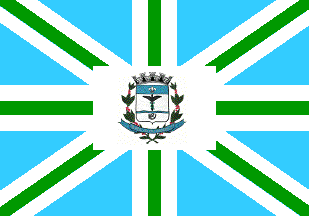 image by
Ivan Sache,
18 February 2013
image by
Ivan Sache,
18 February 2013 Based on: http://www.tupipaulista.sp.gov.br/_portal/simbolos/ver.asp?id=2

Last modified: 2013-03-02 by ian macdonald
Keywords: sao paulo | tupi paulista |
Links: FOTW homepage |
search |
disclaimer and copyright |
write us |
mirrors
 image by
Ivan Sache,
18 February 2013
image by
Ivan Sache,
18 February 2013
Based on:
http://www.tupipaulista.sp.gov.br/_portal/simbolos/ver.asp?id=2
A blue field, bearing a diagonal saltire and an upright cross, all arms green, bordered white, and in the centre a white rectangle bearing the municipal arms.
Official website at
http://www.tupipaulista.sp.gov.br
Dirk Schönberger,
18 February 2013
Tupi Paulista was founded in 1941 by Lélio de Toledo Pizza e Almeida, with the help of the engineer Francisco Cunha. The settlement was originally named Tupy, subsequently changed for Gracianópolis. The district of Gracianópolis was established on 30 November 1944, as part of the municipality of Lucélia. Coffee cultivation was initiated in 1948; in the 1960s, a rural population of c. 11,000 grew 18 millions coffee trees. The municipality of Gracianópolis was established on 24 December 1948 and renamed Tupi Paulista on 30 December 1953.
The symbols of Tupi Paulista are prescribed in Article 2 of the Municipal Constitution, adopted on 31 March 1990 and last amended on 20 September 2011, as "the coat of arms, the flag, the anthem and other symbols established by Municipal Law, representing the municipality's culture and history."
The symbols of Tupi Paulista, designed by Arcinoé Antonio Peixoto de Faria, are prescribed by Municipal Law No. 1,066 of 29 July 1966.
http://camaratupipta.sp.gov.br/_portal/leis/ver.asp?id=682 - Municipal Constitution
The flag is blue, quartered by a white-green-white cross and a white-green-white saltire. In the middle of the flag is placed a white rectangle charged with the municipal coat of arms. The flag has the same dimension as the national flag, that is 9 units x 13 units*. The dimension of the white rectangle is 4 units x 13** units. The stripes are 2/3 of a unit***, divided into equal parts.
The design of the flag is compliant with the traditions of Portuguese heraldry, inherited in Brazil. The coat of arms represents the municipal government. The stripes represents the municipal power spreading all over the municipal territory. The quarters represent the rural estates located in the municipality.****
*The official proportions of the national flag are 7:10, which is very
close to 9:13 (0.70 vs. 0.69).
**This does not make sense
***This must be the height of each individual stripe, not of the whole
arm of the crosses.
****The usual mention "The rectangle represents the town as the seat of
the municipality" does not appear here.
http://www.camarafacil.com.br/srv09/pmtupipta/_arquivos/documentos/normas/LEI1066_SIMBOLOS.pdf - Law No. 1,066, full text
Photos of the flag
http://camaratupipta.sp.gov.br/_portal/simbolos/ver.asp?id=2
http://camaratupipta.sp.gov.br/_portal/noticias/ver.asp?id=901
http://www.camaratupipta.sp.gov.br/_portal/noticias/ver.asp?id=54
http://www.tupipaulista.sp.gov.br/_portal/noticias/ver.asp?id=314
http://www.ailtomribeiro.com.br/internas.php?pg=noticiasdetalhes¬icia_id=22
http://www.smetupipaulista.com.br/escolas/index.php?blog=5&m=200706
The coat of arms is "A Samnitic shield surmounted by an eight-towered mural crown argent. Argent a fess wavy azure cantoned by a caduceus sable with snakes vert and a hunting horn sable, a chief azure a fleur- de-lis argent. The shield supported by two branches of coffee fructed proper. Beneath the shield a scroll azure inscribed with the motto 'TRABALHO - PAZ - PROGRESSO' [in letters argent]."
The Samnitic shield, the first style of shield introduced from France to Portugal and inherited by the Brazilian heraldry, evokes the Latin colonizers and main builders of the country. The mural crown is a symbol of municipal emancipation, representing a second-rank town, seat of a "comarca". Argent is a symbol of peace, friendship, equity, justice and work. The caduceus, according to Ronchetti***, belongs to heroes; raised in wartime by heralds and envoys, the caduceus is a staff with two coiled up snakes surmounted by two displayed wings, so that the upper part of their bodies forms an arch. The caduceus is a mythological symbol of Mercury, symbol of peace and friendship. The staff is a symbol of power. The snake is a symbol of prudence, representing on the caduceus sharpness and prudence required for eloquence. The coat of arms, therefore, symbolizes the austere government, whose efficient acts result in the progress of the municipality. Sable is a symbol of strength, constancy, prudence, knowledge and moderation. Vert, the colour of the snakes coiled up around the caduceus, is a symbol of civility, triumph and abundance. It is also the colour of hope, alluding to the greening fields in spring promising profuse harvests. The fess wavy represents the geographic zone of river Paraná, where the municipality is located. The hunting horn represents cattle breeding as one of the main sources of income of the municipality. The chief azure with the fleur-de-lis argent represents the municipality's patron saint, the Blessed Virgin. The branches of coffee represent the main crops in the region. The motto, reading "Labour - Peace - Progress" is a synthesis of the coat of arms.
The dimensions of the coat of arms are 7 units x 8 units.
***"Caduceo", pp. 173-174 in: Giuseppe Ronchetti, "Dizionario illustrato dei simboli; simboli, emblemi, attributi allegorie, immagini degli dei, ecc.", Ulrico Hoepli, Milano, 1922 (available online, http://archive.org/details/dizionarioillust00roncuoft) Peixoto is quite faithful to the source, although somewhat elliptical. Ronchetti explains that the caduceus is a symbol of peace because Mercury used it to pull apart two struggling snakes. Mercury added wings to the staff because he is also the god of eloquence. Friendship, power and prudence are not mentioned.
http://www.camarafacil.com.br/srv09/pmtupipta/_arquivos/documentos/normas/LEI1066_SIMBOLOS.pdf - Law No. 1,066, full text
Ivan Sache, 18 February 2013
Anything below the following line isnt part of the Flags of the World Website and was added by the hoster of this mirror.




